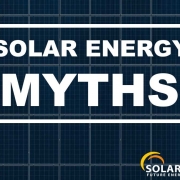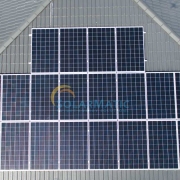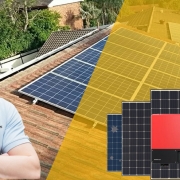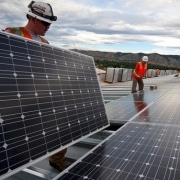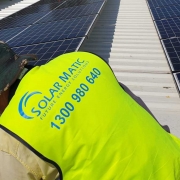Rising electricity prices and the RET ending: experts discuss Australia’s renewable energy future
With no concrete plans to replace the Renewable Energy Target or RET that is due to come to an end in 2030 (and will reduce in value year-on-year until this date), it may give the impression that the industry is downbeat about the future of solar power and battery storage systems.
The RET is an Australian Government scheme that is designed to encourage the uptake of renewable energy generation – a market mechanism that provides financial incentives for both small solar installations and large-scale renewable energy power plants. So, will solar suddenly be out of reach for most people after the RET finishes? Could there, in fact, be a ‘double hit’ to the consumer: more expensive solar energy systems combined with ever-increasing electricity prices?
The answer is an upbeat ‘No’.
In fact, the future of solar power and other forms of renewable energy looks positive. In this article, two experts on Australia’s energy market talk about why solar and wind will continue long after the RET ends, and explain why your electricity bills are so high.
Why do our electricity networks cost so much?
Dr. Archie Chapman is a Research Fellow in Smart Grids at the University of Sydney’s School of Electrical and Information Engineering. His research focuses on maximizing the efficient use of our existing energy networks to avoid costly investment in network expansion – which makes up a huge proportion of our power costs.
In fact, it’s not the generation of electricity that makes up the bulk of our electricity bills, it’s the cost of maintaining the distribution network that carries it to the end user.
“The network cost is more than a third of the typical customer’s retail bill,” Chapman says. “Most of that comes from the fixed cost of putting poles and wires in. But a fair bit comes from maintaining the network and augmenting it when demands on existing parts of the network exceeds what the network is rated to deliver. To be precise, that’s in the transformers – the substations and kiosks you see around the place. They cost a lot of money to manufacture, install and maintain.”
The reason for the high cost of our electricity network, Chapman says, is that over the last 10 or 15 years there was actual growth in residential power use. The driver was an increase in high-powered home devices, largely air-conditioning.
But there were also predictions by Australia’s energy regulators about how much electricity use would increase. To match this predicted requirement, the regulators told electricity network companies to invest in the network by performing capacity upgrades.
The move to a National Energy Market (NEM), Chapman says, also meant those networks that did not meet NEM standards had to upgrade.
Paying for a boom that didn’t happen
“So distribution networks built up more networks to meet those forecast increases in loads. But at the same time there was a big efficiency push in those consumer devices.”
The cost of paying for Australia’s electricity networks adds to our power bills.
In fact, although networks invested in infrastructure, increased electricity use across the network did not eventuate. Chapman says energy regulators should have looked more carefully at the forecast electricity increases and at the investment going into the networks. Because Australians are now paying for a predicted boom in electricity use that did not occur.
“To their credit, [the regulators] fixed that up over the last couple of determinations. So we could even see over the next regulatory period a decrease in network costs. In most states we’re expecting to see that. Of course, the wholesale market energy prices are going up, so customers won’t see any relief in their bills.”
Battery storage vital to future of solar power
Renewable energy will bring electricity costs down, after initial plant outlay, but its intermittent nature – due to overcast weather or lack of wind – means energy storage is vital.
Chapman believes this issue can be solved through engineering solutions, and he’s looking to our rivers and the ocean for answers. That’s because water stored in a reservoir that then falls to a lower one unleashes energy that can be converted to electricity.
“There a lot of proposals for smaller-scale pumped hydro storage, whether it be off-river or connected to the sea,” Chapman enthuses. “The big benefit [of using seawater] is that the lower reservoir is the sea, so you only need to build one reservoir.
“The downside is that you’re dealing with seawater, which is notoriously corrosive. But these are engineering challenges rather than impossibilities. We can get around it.”
How successful was the Renewable Energy Target?
The Renewable Energy Target (RET) is a Federal Government scheme started by the Howard Government in 2001. It amounts to a government installation subsidy on a residential, business or industrial solar power or wind energy system. If you have solar panels on your roof, the RET probably subsidised them to some extent. The scheme ends in 2020.
Commenting on the RET’s imminent demise, Chapman says if its goal was to reduce the emissions intensity of industry in Australia, then the RET has been “largely successful”. It changed the generation mix by encouraging investment in renewables, he says. But at the same time Australia had a substantial collapse in manufacturing, which has reduced the overall demand for energy, which also helped us achieve lower emissions.
Chapman is optimistic about solar power continuing to be popular beyond the RET’s lifespan. “Costs are continuing to trend down, particularly with the inverters that connect the panels to the network. By 2020 we may see solar as being a viable investment for a lot of people even without the subsidy.”
Despite RET ending, on a level playing field, solar power wins
Wilf Johnston is Managing Director, Australia at Flex, the parent company of Energy Matters. Johnston holds a Bachelor of Engineering and a Bachelor of Commerce from the University of WA, so he’s well-placed to observe the technical and financial environment around energy.
He believes the RET’s CO2 emissions target will be met “pretty easily”, and that the government is right to let the scheme close in 2020. He’s also positive about the Federal Government’s new National Energy Guarantee (NEG), which will replace the RET, because he believes that on a level playing field, with no subsidies for coal or renewables, renewable energy wins.
“I think they quite rightly are trying to move away from a renewables-only strategy and instead looking at an energy strategy,” he says. “You have a situation now where renewables are undeniably a key part of the energy mix, if not the key part of the energy mix. So it makes sense to marry all those schemes together and create something that meets our energy requirements as a whole.
On a level playing field, solar wins over coal every time, says Wilf Johnston.
“If they set the [NEG] scheme up correctly, we can compete on price, we can compete on emissions, we can compete on reliability – we win on all of those.”
However, Johnston says concerns do remain about the NEG. As the details appear, “some weird pro-coal distortion” could appear in the scheme. There’s also the possibility that the investment community will see the change from RET to NEG as a signal the Federal Government is not providing a stable framework in which to invest in the future of solar power and other renewables.
Global investment banks, not pollies, control energy
A significant change in thinking over the last 12 months is that people now realise Australian power stations are largely assets of global investments banks.
“And global investment banks aren’t looking at Abbott and Turnbull or Kevin Andrews, they’re looking at global trends,” he explains. “Because they are investing for the long term, investing in assets that they can anticipate holding for 20 years. They don’t see [local] distortions as important, because they see the trends at the global level and they can see where the debt needs to be priced for these assets.
Global investment banks own much of Australia’s power generation.
“So when they’re pricing a debt for a coal-fired asset, they pass it by. Because, ultimately, they know that the thing is dead. If they’re pricing a debt for a solar asset, they price it low. Because they know that’s where the business is going to be. It almost removes the significance for some of these political decisions for long-term assets.”
Networks and retailer competition add to power bills
On the topic of electricity prices, Johnston says the law allows network owners to build out their assets. They then charge the cost back to the customer through power bills. When network owners invest in major infrastructure, consumers pay the price.
“We’re on the hook,” he says, adding that network costs account for up to 50 per cent of electricity bills.
“Then you’ve got the marketing and customer retention costs for the retailers. The down side of competition is you have 20-odd electricity retailers out there busily marketing to steal customers from each other and that costs money. That’s a good 25 per cent of the bill as well. So the actual energy component of the bill is low, at least for residential customers.”
Australia’s renewable energy future
Johnston says Australia’s future of solar power and other renewable energy mix is going to include more energy storage in batteries. Directing power use within the home using smart devices will also be playing a role. “Like Flex PowerPlay, it will direct energy to the place where you need it and when you need it based on the tariff. If we can integrate that with energy retailers as well then everyone wins,” he says.
“They could say to the consumer that if you run your washing machine at a time of day that’s better for us, we can give you a bit of a break. There’s a little bit of a technology gap there, it’s not hardcore R&D, it’s just the user interface, making it easy for people to use these devices. That’s what’s going to make the difference.”






